e-Medicine Description
E-medicine / telemedicine
- Use electronic means for medical data transfer;
- Performing clinical practices;
- Medical record keeping, data processing, and information sharing;
- Teleconsultation (Isabalija, Mbarika, & Kituyi, 2013).
e-medicine or telemedicine is an innovative solution enhancing health service deliver. It is based on electronic platforms to transfer medical data from different locations. At advanced stages, e-medicine is deployed to support or provide clinical services through telecommunication methods, such as teleconferencing (Isabalija, Mbarika, & Kituyi, 2013). Simple usages include keeping of medical records, data capture, data processing, and information sharing. Further, e-medicine is effective for teleconsultation, which involves consultancy services to patients and/or physicians.
Factor responsible
- The Internet;
- Smartphones / technologies;
- Savvy healthcare consumerism / educated patients;
- Information revolution;
- Innovation and Quality Improvement efforts (Om, 2015).
The Internet is largely responsible for driving e-Medicine. In addition, increased usages of communication mobile devices and networks across the world have increased the applications of such devices in healthcare delivery. Educated patients continue to use technologies and demand flexibility while information revolution supports knowledge acquisition (Om, 2015). Constant innovation and the need for Quality Improvement in the healthcare industry are also responsible for e-Medicine growth.
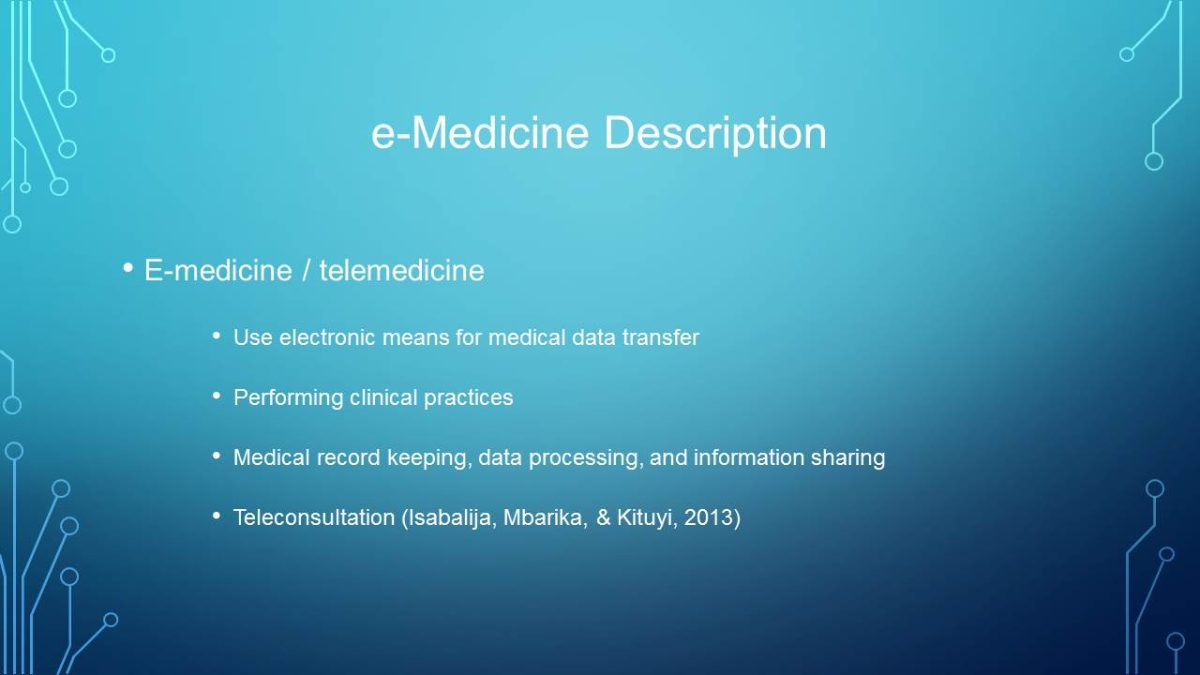
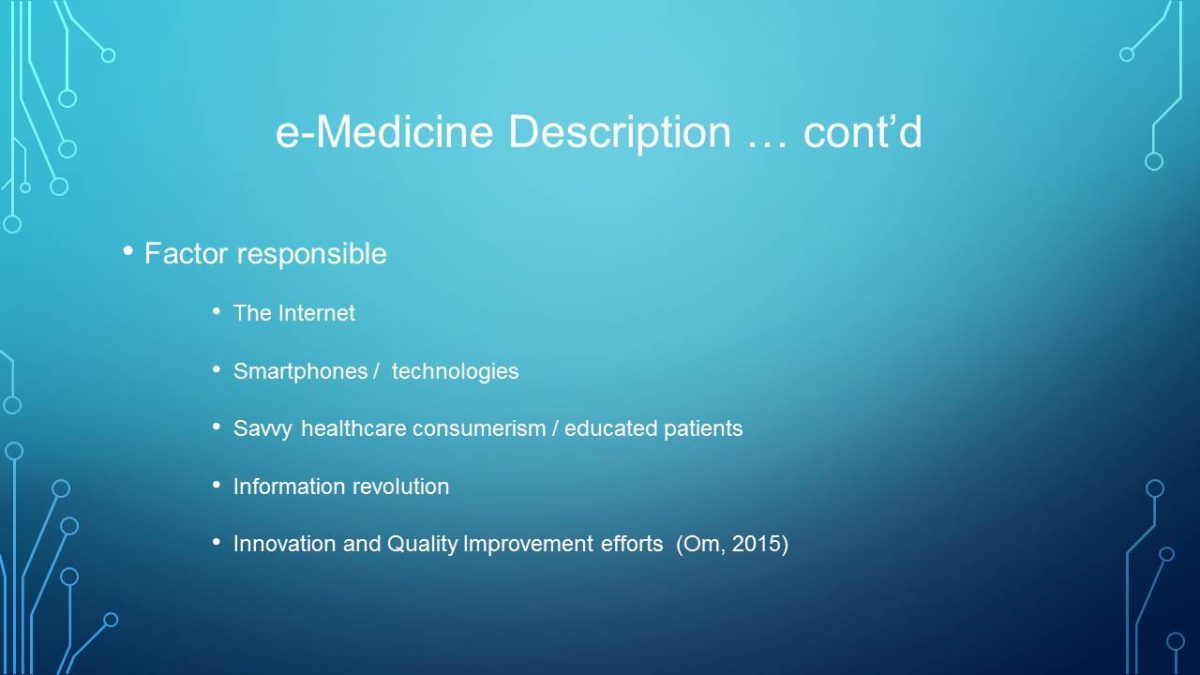
e-Medicine Benefits
- Overcome geographical limitations;
- Enhanced access to healthcare;
- Cost-cutting;
- Speed up referral processes;
- Eliminate unnecessary referrals;
- Improve care quality and reduce readmission (Isabalija et al., 2013).
e-medicine offers some benefits in situations where access to healthcare is constrained with various factors. Geographical location limits accessibility to healthcare services and resources. It reduces cost while improving access (Isabalija et al., 2013). e-medicine enhances communication and speed of referrals, eliminates unnecessary referrals, readmissions while advancing Quality Improvement.
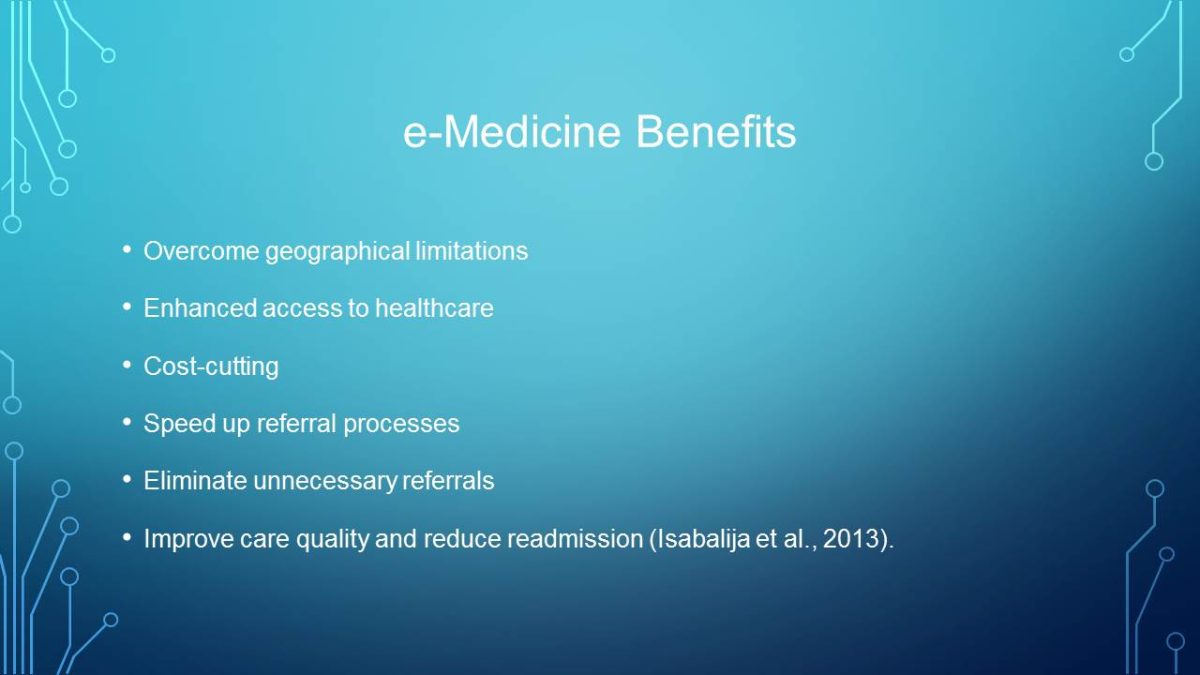
Telehealth Description
Telehealth
- Means of providing healthcare services and public health via information and communication technologies;
- Facilitates:
- Diagnosis;
- Consultation;
- Treatment;
- Education;
- Care management;
- Patient self-management (American Hospital Association, 2015).
Telehealth is a method of providing healthcare services and public health through information and communication technologies. It facilitates diagnosis, consultation, treatment, education, care management, and patient self-management when the patient and the physician are in different locations. It enhances patient self-management and caregiver support for patients and includes synchronous relations and asynchronous store and forward transfers (American Hospital Association, 2015).
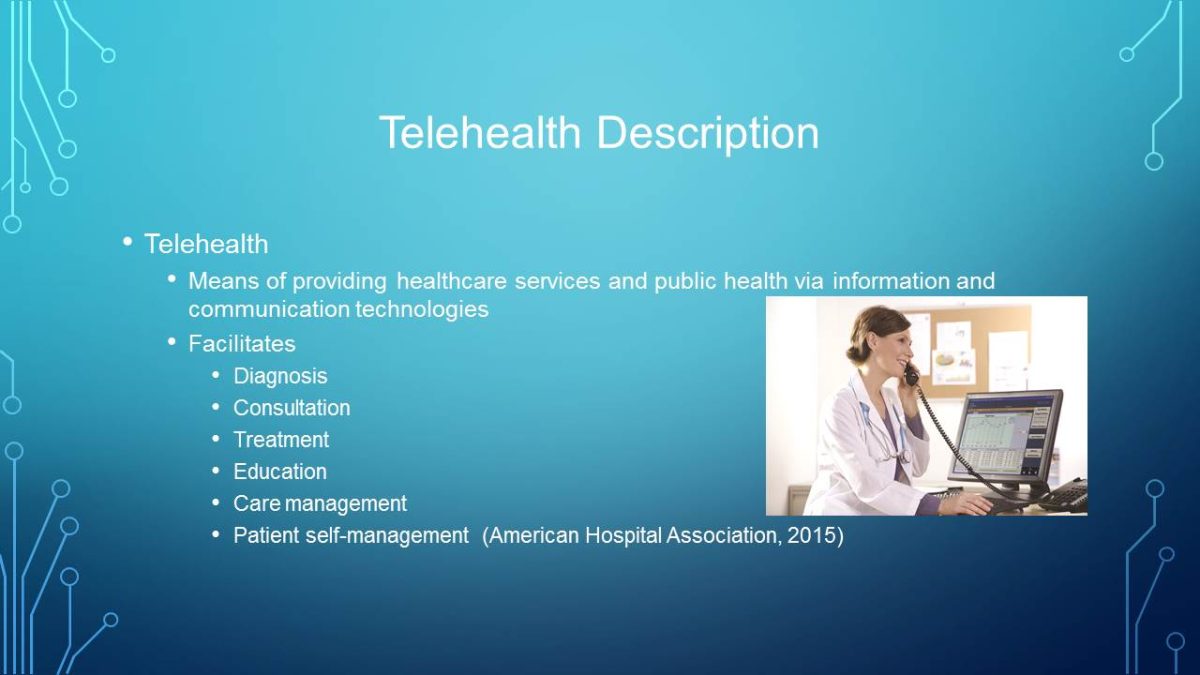
Telehealth Traditional Modalities
Real-Time:
- Live video-conferencing.
Store-and-Forward:
- Videos, digital images, audio, and clinical data captured and transferred to physician.
Remote Patient Monitoring:
- Patient data captured to monitor patient remotely (American Hospital Association, 2015).
Traditional, telehealth has operated on three modalities. Real-time involves live communication between the patient and provider. It involves the use of video conferencing to support telepsychiatry, telehomecare, telecardiology and remote consults (teleconsults) with specialists, primary care physicians, counselors, social workers and other health care professionals (American Hospital Association, 2015).
Store and forward is a mode that allows images, videos, audios, and clinical data to be captured, stored and forwarded to physicians for analysis. It is common in teledermatology and telepathology.
Finally, remote Monitoring collects data from sensors and monitoring devices for remote monitoring of chronic conditions, such as diabetes, heart diseases, and asthma among others.
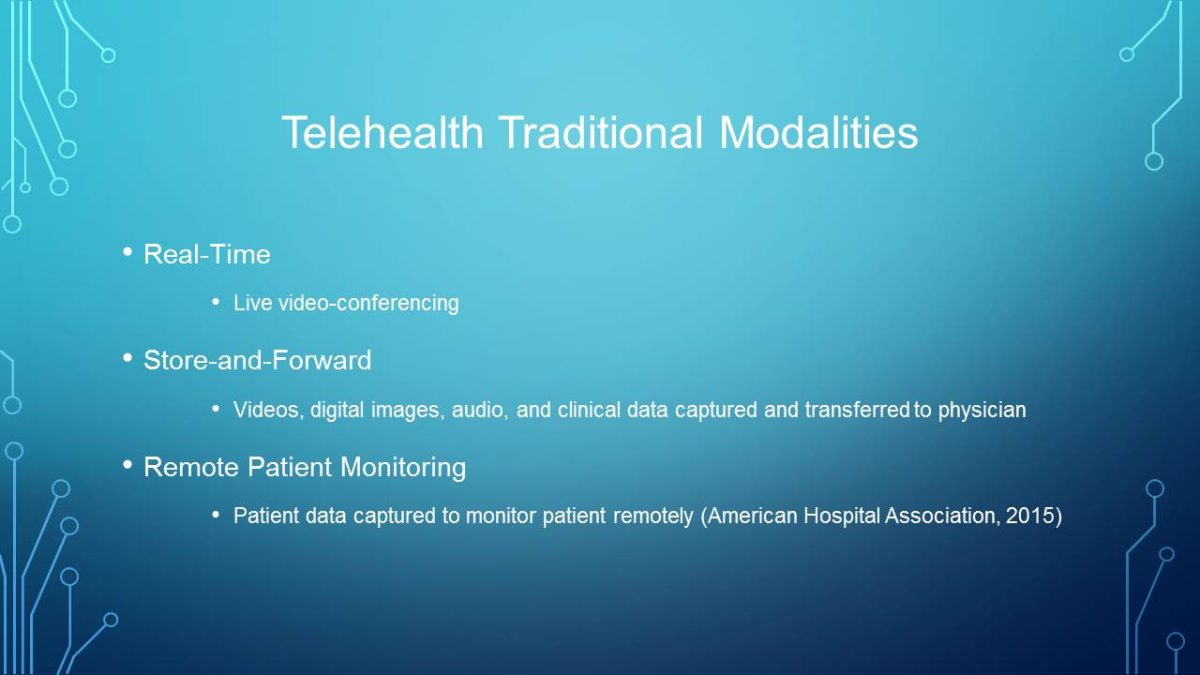
Compares and Contrasts Available Models and Systems
From the review of available platforms and models, there are more than ten platforms for telehealth for different services. The models are also many across various areas of medical specialization (Georgia, Kaffashi, Jacono, & Loparo, 2015; American Hospital Association, 2015). Most of these platforms and models have attained the FDA approval and have some specific distinctions. For instance, InTouch for telestroke is now classified as a class II Medical Device Data System, as the only model with that classification.
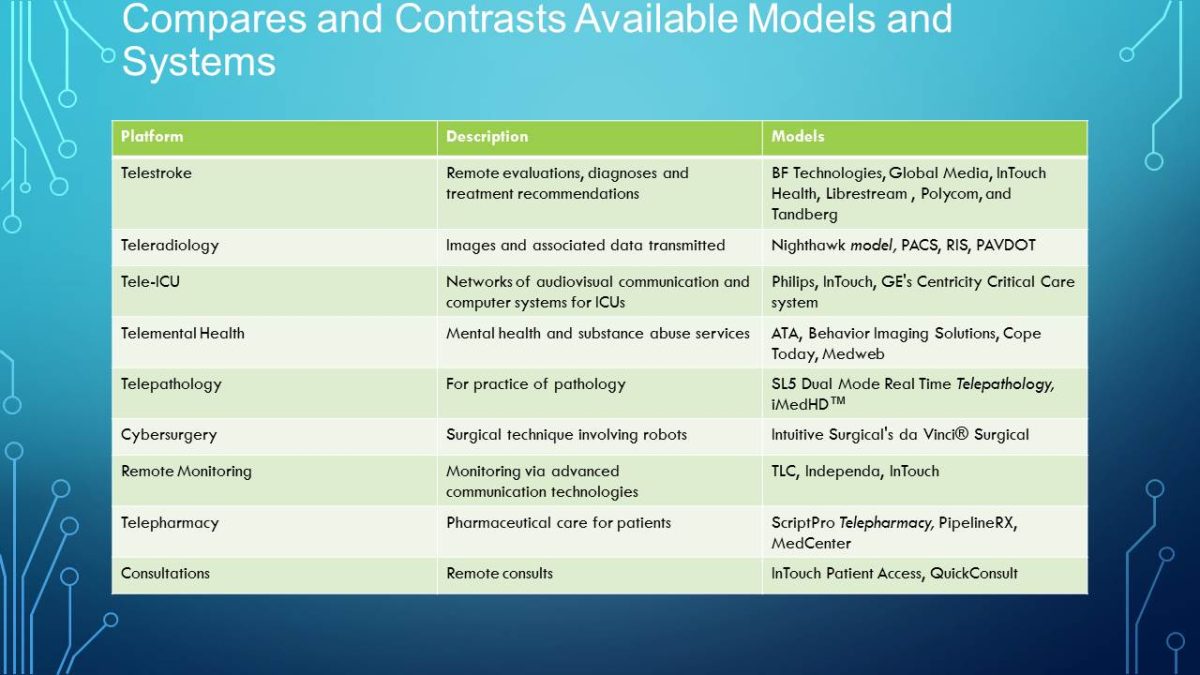
Recommendation to Move to Telehealth
- Improving access to healthcare and convenience;
- Improving quality of care and patient satisfaction;
- Cost-cutting;
- Reimbursement based on states (Full Parity, Partial Parity, and No Parity);
- Cross-sector care integration (IT and health);
- Care personalization (Lambert, Gale, Hartley, Croll, & Hansen, 2015).
Healthcare providers have continued to adopt telehealth technologies because of inherent benefits to both care providers and patients (Lambert, Gale, Hartley, Croll, & Hansen, 2015). For instance, convenient access for patients and low costs associated with service provision are some major advantages (Dinesen, et al., 2016). The only major issues are related to effective adoption and implementation, which can be managed through various change management and quality improvement models (Jenkins-Guarnieri, Pruitt, Luxton, & Johnson, 2015).
Available clinical evidence also demonstrates these benefits associated with telehealth (American Hospital Association, 2015; Jenkins-Guarnieri et al., 2015; Lambert et al., 2015).

Some Data on Telehealth
Telehealth is gaining popularity while private payer coverage and reimbursement differ across states.
The American Hospital Association has shown that patients have positively embraced telehealth services. However, reimbursement continues to present significant challenges for some providers (American Hospital Association, 2015).
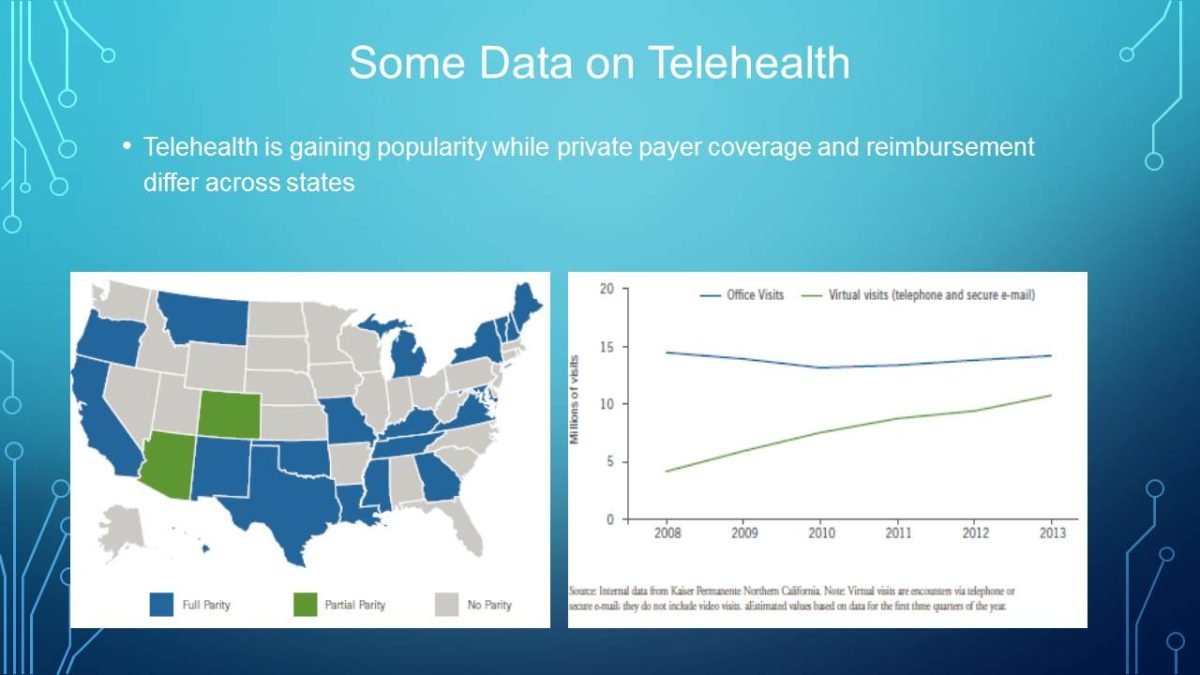
How Data Tracking is Improved through Telehealth
- Secure methods of data capture and transfer;
- Effective principles of data management;
- Patients track their health data and status;
- Increased adoption of EHR technologies;
- Application of the Health Insurance Portability and Accountability Act (HIPAA) for protection.
Data are captured, stored, and transferred using secure channels. Hospitals now focus on effective principles of data management, track their patient data and health status through increased adoption of EHR technologies. In addition, HIPAA has also become relevant to define data ownership across various data handlers (Dinesen et al., 2016).
Telehealth has improved patient data tracking. In fact, data are now more personalized while community data can only be generated for decision-making.
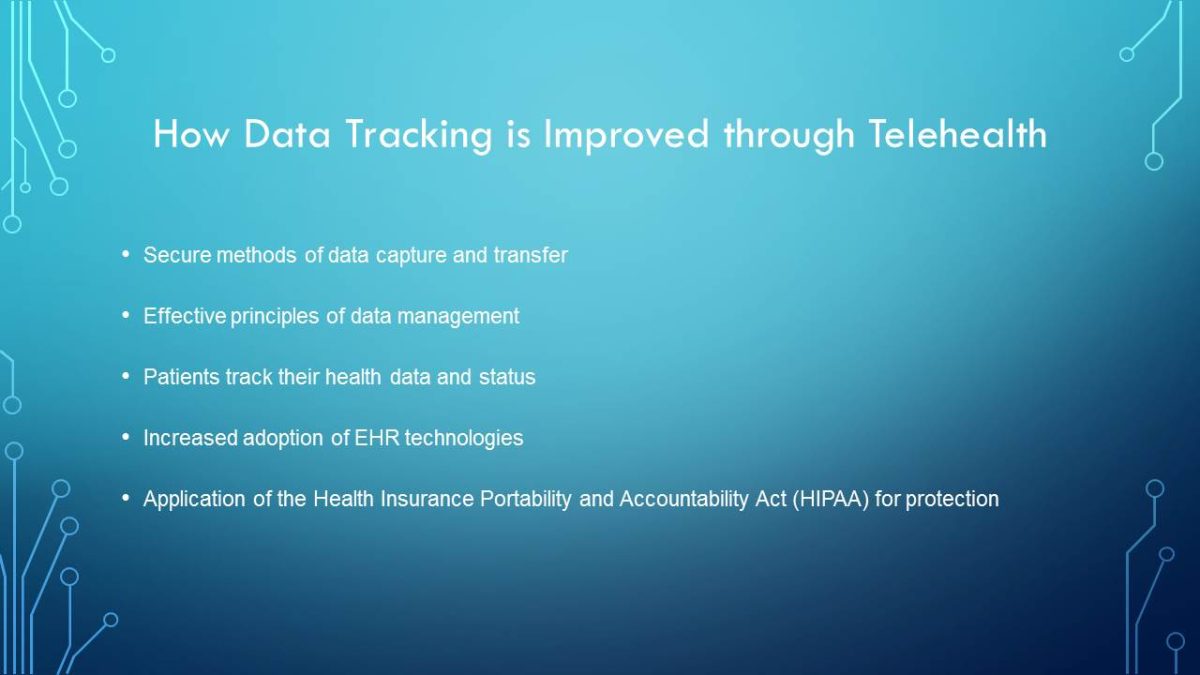
References
American Hospital Association. (2015). The Promise of Telehealth For Hospitals, Health Systems and Their Communities. TrendWatch. Web.
Dinesen, B., Nonnecke, B., Lindeman, D., Toft, E., Kidholm, K., Jethwani, K., . . . Nesbitt, T. (2016). Personalized Telehealth in the Future: A Global Research Agenda. Journal of Medical Internet Research, 18(3), e53.
Georgia, M. A., Kaffashi, F., Jacono, F. J., & Loparo, K. A. (2015). Information Technology in Critical Care: Review of Monitoring and Data Acquisition Systems for Patient Care and Research. The Scientific World Journal, 2015, 1-9. Web.
Isabalija, S. R., Mbarika, V., & Kituyi, G. M. (2013). A Framework for Sustainable Implementation of E-Medicine in Transitioning Countries. International Journal of Telemedicine and Applications, 2013, 1-12. Web.
Jenkins-Guarnieri, M. A., Pruitt, L. D., Luxton, D. D., & Johnson, K. (2015). Patient Perceptions of Telemental Health: Systematic Review of Direct Comparisons to In-Person Psychotherapeutic Treatments. Telemedicine Journal & e-Health, 21(8), 652-60.
Lambert, D., Gale, J., Hartley, D., Croll, Z., & Hansen, A. (2015). Understanding the Business Case for Telemental Health in Rural Communities. Journal of Behavioral Health Services & Research, 42(4), 1-13.
Om, A. (2015). E-Medicine: What It Means for Patients. American Journal of Medicine, 128(12), 1268–1269.